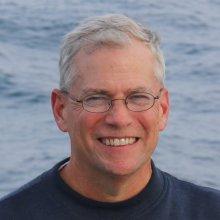
William Burnett
Tell us about your work / research. What kinds of things do you do?
I share operational responsibility for a fleet of six survey ships, over 2,000 civilian and military personnel and a budget over $300 Million. I also serve as a Computational Technology Area Leader in Climate, Weather, and Ocean for the Department of Defense’s High-Performance Computing Modernization Office.
What sparked your initial interest in your career?
Growing up along tornado alley in Oklahoma I became fascinated in (and terrified of) tornadoes and severe weather. My family lived next to an Air Force meteorologist who worked at Tinker Air Force Base and he would bring weather maps to me when I was around ten years old. So I studied the maps and became interested in meteorology.
Who influenced you or encouraged you the most?
A television meteorologist named Gary England. He was a pioneer in the industry - using radar to predict tornado locations, announcing his own tornado warnings and sending chasers out to the field for live tornado broadcasts.
What element of your work / study do you think is the most fascinating?
Right now, studying the imagery from the new GOES-S satellite and watching new thermodynamic processes that have never been seen in such detail before.
What other jobs led you to your current career?
Prior to being promoted to the Senior Executive Service in January 2012, I worked at the National Data Buoy Center, recognized as a world leader in providing operational, real-time marine observations by being named the world’s first Regional Marine Instrumentation Center. I also served on the International Tsunami Commission and as the U.S. National Representative to the World Meteorological Organization’s and Intergovernmental Oceanographic Commission’s Data Buoy Cooperation Panel. Before joining the National Weather Service in 2004, I was the Plans and Programs Division Head at the Naval Meteorology and Oceanography Command. In 1992, I joined the staff of the Naval European Meteorology and Oceanography Center in Rota, Spain, and served as the Oceanographic Services Officer where I developed a new data exchange system that provided products and observations to the Fleet during Operation Provide Promise/Deny Flight. I joined the Naval Oceanographic Office in 1988 as a meteorologist at the Operational Oceanography Center and began my career in 1985 as a physical science aide and storm chaser with the Storm Electricity Group at the National Severe Storms Laboratory in Norman, Okla.
What are your degrees and certifications?
I received a bachelor’s of science in meteorology from the University of Oklahoma in 1988 and I received masters and doctoral degrees in marine science from the University of Southern Mississippi.
What are your hobbies?
Running and reading.
What advice would you give to someone who wants to have a career like yours?
Take the road less traveled by - and that will make all the difference.
